Dani Harper's Blog, page 23
February 22, 2011
Haunted Ships and Ghostly Vessels
 When, steadily steering landward,
When, steadily steering landward,A ship was seen below,
And they knew it was Lamberton, Master,
Who sailed so long ago.
On she came, with a cloud of canvas,
Right against the wind that blew.
Until the eye could distinguish
The faces of the crew.
Then fell her straining topmasts,
Hanging tangled in the shrouds,
And her sails were loosened and lifted,
And blown away like clouds.
And the masts, with all their rigging,
Fell slowly, one by one,
And the hulk dilated and vanished,
As a sea-mist in the sun!
-- from THE PHANTOM SHIP
by Henry Wadsworth Longfellow
Some of the most amazing paranormal events occur at sea. A ghost ship falls into one of three categories. One is the sighting of a phantom vessel that is known to have sunk. Two, a ship can be haunted whether it's still in use or decommissioned, whether it's been turned into a museum or is destined for the scrapyard. Three, a "ghost ship" can be a vessel that mysteriously turns up without a living soul on board.
The Mary Celeste
Originally named The Amazon, this 100-foot brigantine was built in Nova Scotia, Canada in 1861. Her ill luck appears to have started early, with the death of her captain on her maiden voyage. Two other captains died aboard the Amazon. A collision with a fishing boat sent her back to the shipyard for repairs, where a fire broke out on board! Later, on her first trans-Atlantic crossing, she collided with another ship in the English Channel and her captain was dismissed. In 1867 the ship ran aground in Nova Scotia and was sold as salvage.
 Repaired and renamed the Mary Celeste, the ship left New York in 1872. It was loaded with 1700 barrels of raw alcohol and bound for Italy, where the alcohol would be used for fortifying wines. Captain Benjamin Briggs and the seven members of his crew had reputations as experienced and able seamen. Expecting no difficulty, the captain brought his wife and daughter along for the voyage.
Repaired and renamed the Mary Celeste, the ship left New York in 1872. It was loaded with 1700 barrels of raw alcohol and bound for Italy, where the alcohol would be used for fortifying wines. Captain Benjamin Briggs and the seven members of his crew had reputations as experienced and able seamen. Expecting no difficulty, the captain brought his wife and daughter along for the voyage.A month later another merchant ship, the Dei Gratia, spotted the Mary Celeste off the coast of Portugal. The ship was under sail but its sails were tattered and it was behaving strangely. It was soon discovered that there was no one on board. Only nine barrels were missing from the cargo and a six-month supply of food and water was still on board. All personal possessions were undisturbed and there were no signs of a struggle. The lifeboat was missing and a long 3-inch-wide rope was discovered attached to the ship with the opposite end frayed and trailing in the water.
The fate of the captain, crew and passengers of the Mary Celeste remains unknown to this day. But misfortune continued to stalk the vessel. When it was returned to New York, an accident on board caused the drowning of Harry Winchester, father of one of the four owners. Reputed to be cursed, the Mary Celeste went through the hands of 17 owners over the next 13 years! The last owner deliberately wrecked the ship on a reef in the Caribbean.
Alabama's Phantom Steamboat
The Eliza Battle was a luxurious side-wheeled paddle steamer that had hosted presidents and many other prestigious passengers as it traveled the Tombigbee River in Alabama. In addition to some wealthy clientele, the Eliza Battle was also carrying a thousand bales of cotton on her main deck on the night of March 1, 1858, when a fire broke out. Strong winds quickly whipped the flames out of control. Most of the passengers and crew leapt from the ship, but many succumbed to the frigid water before they could be rescued. The steamboat finally came to rest outside Pennington at Kemp's Landing, and the burnt-out hull still remains on the river bottom there.
To this day, sightings of a flaming ship are reported in the area on cold and windy nights. It has been said that music can be heard playing within the ship while fire engulfs the deck! The appearance of the ghostly Eliza Battle is considered an ill omen by fishermen and ship captains alike, a warning of disaster.
 The U-Haul company added the image of Nova Scotia's
The U-Haul company added the image of Nova Scotia'smysterious burning ship to its gallery of paintings used
to decorate the sides of its moving vans! The Flaming Ship of Nova Scotia
Numerous sightings of a three-masted sailing ship have persisted for nearly three centuries in Canada. Most recently, the burning vessel was been seen by several drivers at once on a coastal road, and the apparition remained visible for an astonishing two hours! The nameless ship is described as completely engulfed in flames, or sometimes outlined in a fiery glow. The ghostly vessel has usually been seen sailing the Northumberland Strait between Prince Edward Island and Nova Scotia. There have been a number of attempts over the years to reach the flaming ship by boat, but it vanishes each time.
The Lone Lifeboat
In 1906, the SS Valencia, an iron-hulled passenger liner, was making its way from San Francisco to Seattle. A severe storm caused it to miss its destination and run aground on a reef off the southwest coast of Vancouver Island. The situation was horrific, with the Valencia trapped between the pounding waves and sheer cliffs. Rescuers could not get to the stricken vessel by sea or by land, and could only watch helplessly from a distance as the sea tore the ship to pieces and 136 people perished. Thirty-seven survivors were eventually rescued from the forbidding coastline.
In 1910, Seattle area newspapers reported the sighting of a phantom ship resembling the Valencia on the rocks where she perished. Native fishermen claimed to have seen a lifeboat filled with skeletons.
A single lifeboat from the Valencia was found floating in the area -- 27 years after the sinking! It was in remarkably good condition despite being exposed to the elements for so long. Part of this lifeboat, still bearing the name Valencia, can be seen at the Maritime Museum in Victoria, British Columbia.
Ghost Ship of the Arctic
 The Baychimo, locked in ice in 1931The Baychimo was a steel cargo steamer used by the Hudson Bay Company for transporting furs along the Arctic coastline and carrying supplies to Inuit communities. In October 1931, the Baychimo was near Barrow, Alaska when it became blocked by sea ice. The crew left the ship to seek shelter on land, but returned when the ship broke free a week later. It was only a few days, however, before the ship was again trapped. The crew returned to land, knowing they would have to wait until spring before the ship would be free again. A month later the ship vanished during a blizzard!
The Baychimo, locked in ice in 1931The Baychimo was a steel cargo steamer used by the Hudson Bay Company for transporting furs along the Arctic coastline and carrying supplies to Inuit communities. In October 1931, the Baychimo was near Barrow, Alaska when it became blocked by sea ice. The crew left the ship to seek shelter on land, but returned when the ship broke free a week later. It was only a few days, however, before the ship was again trapped. The crew returned to land, knowing they would have to wait until spring before the ship would be free again. A month later the ship vanished during a blizzard! The crew thought at first that the Baychimo had broken up and sunk, but a seal hunter told them that he'd seen it 45 miles away. When they tracked the ship down, the captain decided that it couldn't possibly survive the winter. The crew removed the most valuable furs and abandoned the vessel to its fate.
The Baychimo did more than survive until spring, however. For the next thirty-eight years, the Baychimo was sighted again and again along the northern coast of Canada. There were many attempts to board the ship, and a few were successful. Each time, however, the salvagers were thwarted by terrible weather and the ship disappeared once again. The last confirmed sighting was in 1969 when the Baychimo was frozen in sea ice off the coast of Alaska. No one knows whether the ship sank or sailed free to roam the frigid Arctic waters once more.
The Haunted Hornet
 The USS Hornet joined the war in the Pacific in 1943, and quickly became one of its most decorated ships. The Hornet, nicknamed the Grey Ghost, was at the forefront of the action, supporting troop landings, shooting down enemy planes, sinking Japanese battleships and earning no less than nine battle stars for its service. Later in its career, the Hornet recovered the astronauts from the first moon landing mission, Apollo 11, and also those from Apollo 12.
The USS Hornet joined the war in the Pacific in 1943, and quickly became one of its most decorated ships. The Hornet, nicknamed the Grey Ghost, was at the forefront of the action, supporting troop landings, shooting down enemy planes, sinking Japanese battleships and earning no less than nine battle stars for its service. Later in its career, the Hornet recovered the astronauts from the first moon landing mission, Apollo 11, and also those from Apollo 12. In its retirement years, the Hornet was designated as a National Historic Landmark and opened its doors to the public as a museum in Alameda, California. And that's when it came to light that the Hornet has one more distinction – it's arguably the most haunted ship in America.
Workmen, museum staffers and tourists have reported heavy doors opening and closing by themselves, things falling off shelves or large items sliding across the floor, the sudden smell of pipe smoke and the sensation of being grabbed or pushed. Sailors and officers in WWII uniforms have been sighted, moving with purpose as if carrying out their duties as usual. Footfalls are heard where there is no one present, plus voices talking, shouting laughing, even calling for help. Some individuals have heard entire conversations, as if aircraft crews were talking shop.
If there are ghosts aboard the Hornet, no one is surprised. Over 300 men died on the ship, some in combat but many through horrific accidents – an aircraft carrier is a dangerous place. And like all warships, the Hornet had its suicides. Despite this, most of the people who have had paranormal experiences on the old ship say that the spirits tend to be friendly, even playful. And not above playing pranks – one volunteer was alone in a restroom when the urinal beside him flushed by itself.
In recent years the USS Hornet has attracted the attention of many psychics and mediums, and even a number of TV shows such as Ghost Hunters and Ghost Adventures. Fortunately, the average person doesn't need special permission to ghost hunt since the Hornet is open to the public during museum hours. And if the stories are true, then ghost hunting really isn't necessary -- they'll find YOU!
Dani Harper
http://www.daniharper.com/
YOUR TURN -- Not only are ghostly ships the stuff of legends, but they fuel the imagination and inspire great fiction such as Duma Key by Stephen King
 . Have you read a story or a novel, or watched a movie about a haunted vessel?
. Have you read a story or a novel, or watched a movie about a haunted vessel?
Published on February 22, 2011 22:58
January 24, 2011
Rabbits and Luck
 Chinese New Year on February 3, 2011 will usher in the
Year of the Rabbit
, according to the Chinese Zodiac. The Rabbit is said to be the luckiest of all the signs, but this isn't unusual. Rabbits have been associated with luck in many cultures over the centuries.
Chinese New Year on February 3, 2011 will usher in the
Year of the Rabbit
, according to the Chinese Zodiac. The Rabbit is said to be the luckiest of all the signs, but this isn't unusual. Rabbits have been associated with luck in many cultures over the centuries. Rabbit Day
In parts of Britain, the first day of any month is nicknamed "Rabbit Day". Folklore has it that saying the words "rabbit, rabbit, rabbit", "white rabbits", or even "bunny, bunny" upon waking up on the first day of the month will ensure good luck. Forget to do it? Say "tibbar, tibbar" (yup, that's "rabbit" backwards!) before falling asleep that evening.
There are endless variations on this, including saying "black rabbits" just before bed as part of the charm. A two-part ritual calls for you to say "rabbits, rabbits" as you fall asleep on the last day of the month, and "hares, hares" when you rise. By the way, those have to be the first words spoken in the morning!
Rather than doing it monthly, some people believe that saying "rabbit, rabbit" on the first day of the New Year is sufficient to bring luck all year long. Saying it on the first night of the new moon is supposed to be effective too. If it's your birth month, then the luck is supposed to be stronger for you during that time. Some people recite an old British nursery rhyme, which goes like this:
Rabbits hot and rabbits cold,
Rabbits new and rabbits old,
Rabbits tender, rabbits tough,
Never can we have enough!
Here in North America there are many variations of the "rabbit rabbit" ritual, particularly on the East coast. In recent years, the practice has been updated to include tweeting "rabbit rabbit" on the first day of every month! This was a noted trend on Twitter in 2009.
Rabbits, lucky and unlucky
 So why are rabbits thought to be lucky? One explanation has to do with their ability to jump, and it's the reason some folks carry a rabbit's foot – it represents leaping into the future and moving forward in life. Others carry a rabbit's foot to ward off arthritis and rheumatism. In Wales it's been said that brushing the face of a newborn child with a rabbit's foot will keep away evil spirits and bring the child good luck for the rest of his life. Rabbits have often been associated with fertility and abundance, and seeing a rabbit sitting still is supposed to be a good omen.
So why are rabbits thought to be lucky? One explanation has to do with their ability to jump, and it's the reason some folks carry a rabbit's foot – it represents leaping into the future and moving forward in life. Others carry a rabbit's foot to ward off arthritis and rheumatism. In Wales it's been said that brushing the face of a newborn child with a rabbit's foot will keep away evil spirits and bring the child good luck for the rest of his life. Rabbits have often been associated with fertility and abundance, and seeing a rabbit sitting still is supposed to be a good omen.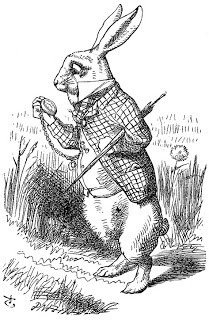 Not everything about rabbits is rosy, however. If you see a rabbit run across your path, it's like the proverbial black cat – bad luck will follow. If a rabbit runs down the street, some superstitions say that fire will soon occur in a nearby home. A variation is if a rabbit runs through your garden, bad luck has just run through your life. In a few parts of Britain, white rabbits were once thought to be witches in animal form and associated with evil spirits! This puts a whole new spin on the classic story of Alice In Wonderland, and all the trouble that Alice gets into by following a White Rabbit. There are remnants of this superstition even today, and in some places white rabbits are shied away from as pets!
Not everything about rabbits is rosy, however. If you see a rabbit run across your path, it's like the proverbial black cat – bad luck will follow. If a rabbit runs down the street, some superstitions say that fire will soon occur in a nearby home. A variation is if a rabbit runs through your garden, bad luck has just run through your life. In a few parts of Britain, white rabbits were once thought to be witches in animal form and associated with evil spirits! This puts a whole new spin on the classic story of Alice In Wonderland, and all the trouble that Alice gets into by following a White Rabbit. There are remnants of this superstition even today, and in some places white rabbits are shied away from as pets! Hunters, farmers and irate gardeners would often refuse to shoot black rabbits for fear of bad luck. In the County of Kerry in Ireland, all rabbits are said to carry the souls of their ancestors. And in England, the appearance of a rabbit on or near a ship was an extremely bad omen, enough to cause a captain to delay or cancel a voyage. It's been said that a fisherman would rather burn a net that had been touched by a rabbit than ever use it again. A story is told of young boys placing rabbit skins on boats to keep their fathers from going away to sea.
Are you a rabbit person?
According to the Chinese zodiac, it is the year of a person's birth that not only determines personality traits, but the degree of success and happiness in life. Those born in the Year of the Rabbit (1915, 1927, 1939, 1951, 1963, 1975, 1987, 1999 and 2011) are considered to be the luckiest of all.
 As well as being articulate, talented, and ambitious, rabbit people are said to be virtuous, reserved, and have excellent taste. Rabbit people are admired, trusted, and are often financially lucky. They are fond of gossip but are tactful and generally kind. Rabbit people seldom lose their temper. They are clever at business and being conscientious, never back out of a contract. They would make good gamblers for they have the uncanny gift of choosing the right thing. However, they seldom gamble, as they are conservative and wise.
As well as being articulate, talented, and ambitious, rabbit people are said to be virtuous, reserved, and have excellent taste. Rabbit people are admired, trusted, and are often financially lucky. They are fond of gossip but are tactful and generally kind. Rabbit people seldom lose their temper. They are clever at business and being conscientious, never back out of a contract. They would make good gamblers for they have the uncanny gift of choosing the right thing. However, they seldom gamble, as they are conservative and wise. A "rabbit year" such as 2011 is said to be calm and relaxed for all of us, much needed after the ferocious "tiger year" it follows. And it's considered to be especially lucky for "rabbit people", enhancing all of your good qualities.
And if this isn't your birth sign, don't worry about your luck. It's never too late to start saying "rabbit rabbit" !
Dani Harper
http://www.daniharper.com/
Your turn – what superstitions about rabbits have you heard? Were you born in the Year of the Rabbit?
Your Chinese Horoscope 2011: What the Year of the Rabbit Holds in Store for You

2011 Year of the Rabbit Forecast for All 12 Chinese Astrology Signs

Published on January 24, 2011 09:20
January 9, 2011
Best time to pre-order Changeling Moon!
Just a quick little note to those of you who not only enjoy exploring the paranormal, but read paranormal romance as well:
My shapeshifter romance, CHANGELING MOON, will hit the bookstores in May but it can now be pre-ordered for less at Amazon.com!
Regular price for the trade paperback is $14, but you can pre-order it today for just $7.77!
Don't you just LOVE Amazon?
Sincerely
Dani Harper
http://www.daniharper.com/
My shapeshifter romance, CHANGELING MOON, will hit the bookstores in May but it can now be pre-ordered for less at Amazon.com!
Regular price for the trade paperback is $14, but you can pre-order it today for just $7.77!
Don't you just LOVE Amazon?
Sincerely
Dani Harper
http://www.daniharper.com/
Published on January 09, 2011 14:52
December 31, 2010
How to Ensure your New Year is Happy
 Most of the traditions connected with New Year's Eve and New Year's Day could be summed up in a single sentence: "What you do is what you'll get". In many cultures, what you do for the first hour of the New Year signifies what you'll do the most of for the next twelve months! (Does sleeping count?) Here are fifteen of the most common superstitions.
Most of the traditions connected with New Year's Eve and New Year's Day could be summed up in a single sentence: "What you do is what you'll get". In many cultures, what you do for the first hour of the New Year signifies what you'll do the most of for the next twelve months! (Does sleeping count?) Here are fifteen of the most common superstitions.1. Working hard on New Year's Day will ensure a whole year of grueling labor! But if you do a small token task successfully – something related to your employment – this will set the tone for achievement. (I'm definitely planning to write something!)
2. If the house is clean by midnight on Dec. 31st, it'll be clean for the entire next year. (Do I have to sort the closets too?) Don't sweep on New Year's Day or you'll sweep out all your good luck! Don't do dishes or laundry either or you'll "wash away" a member of your family in the coming year.
 3. If all your pockets and purses and wallets have coins and dollars in them by midnight, you'll have plenty of money in the new year. Holding a piece of gold or silver in your hand at the stroke of midnight will also bring prosperity. Some people place coins on windowsills and the tops of doors too.
3. If all your pockets and purses and wallets have coins and dollars in them by midnight, you'll have plenty of money in the new year. Holding a piece of gold or silver in your hand at the stroke of midnight will also bring prosperity. Some people place coins on windowsills and the tops of doors too.4. If you wear new clothes on New Year's Day, more new clothes will come your way. (Does that include purses and shoes?)
5. No crying, fighting, arguing, name-calling or general negativity on New Year's Day or you'll have strife and tears all year long.
6. Don't let valuable things leave your house on New Year's Day or luck and fortune will go with them. The general belief refers to things like money and jewelry, but some people believe that nothing – not even garbage! – should leave the house on New Year's Day. Take the empties to the recycling bin some other time!
7. Make sure the cupboards and pantries are full on New Year's Day, in order to ensure abundance the rest of the year.
8. In many countries, it's believed that all debts should be settled before the New Year. Don't pay back loans or lend money on New Year's Day however, or you'll be paying out all year long!
 9. Be careful with the dishes. If anything breaks on New Year's Day, ill luck will follow. And if you break a mirror, the bad luck will be doubled. None of this applies, however, if you're Danish. They save up dishes all year to throw at the doors of their friends and neighbors. At the end of New Year's Day, the higher the pile of broken crockery on your front step, the more loyal friends you have.
9. Be careful with the dishes. If anything breaks on New Year's Day, ill luck will follow. And if you break a mirror, the bad luck will be doubled. None of this applies, however, if you're Danish. They save up dishes all year to throw at the doors of their friends and neighbors. At the end of New Year's Day, the higher the pile of broken crockery on your front step, the more loyal friends you have.10. Working on New Year's Day will ensure a year filled with grueling labor. But if you do a small token task – something related to your employment – successfully, it'll set the tone for achievement in the coming months.
11. Kissing at least one person at midnight ensures that love, friendship and affection will continue. To not give out a kiss indicates a long, cold and lonely year. (That's dire – I'd kiss both my pugs to avoid a fate like that!). Kissing your spouse or your fiance is even better, ensuring that you'll live in love and happiness during the entire year to come.
12. When midnight approaches, open all the windows and doors to let the Old Year leave. In some traditions, just opening one window or door will work. Releasing the Old Year makes room for the New Year. In Puerto Rico, people toss buckets of water out the windows to help to clean out the old year.
 13. Bad luck and evil spirits must be driven away in order to make room for good fortune. This belief is at the root of using noisemakers to welcome in the New Year. The more noise you can make, the better. In early pioneer America. the firing of guns into the air was practiced. Church bells are often rung at midnight in many countries for the same reason.
13. Bad luck and evil spirits must be driven away in order to make room for good fortune. This belief is at the root of using noisemakers to welcome in the New Year. The more noise you can make, the better. In early pioneer America. the firing of guns into the air was practiced. Church bells are often rung at midnight in many countries for the same reason. In Iran, pots and pans are banged together. And the Chinese can be thanked for introducing fireworks to New Year's celebrations to chase away demons and bad fortune. In Wales, singing door to door does the job. My favorite is an Irish tradition which calls for banging on the walls and doors with Christmas bread to frighten evil spirits and invite good ones into the house. (Finally - a good use for that fruitcake!)
14. What you eat is said to influence your fortune for the coming year. It's lucky to eat black-eyed peas, and some say that one pea equals a coin you'll receive. Lentils will work too. But eating cabbage or other leafy greens might be more efficient – they're said to represent bills! Round foods are often synonymous with prosperity. In Spain and Portugal, they eat 12 grapes as the clock chimes midnight, ensuring 12 good months to come. Foods that form a circle or a ring, such as doughnuts, are popular in Europe. (Homer Simpson would like this one) The shape signifies that the year has come full circle and is now complete.
15. In keeping with the "getting rid of the old to make way for the new", residents of Ecuador burn pictures of things they don't want. Each family also creates a scarecrow or puppet which is called the "Año Viejo" or Old Year. Lists of problems and worries might be stuffed inside the effigies, as well as newspaper, wood and sawdust. Setting fire to these effigies is said to destroy any bad things that may have happened over the twelve months. Jumping over the fire brings extra luck. Versions of this practice can be found in other cultures as well. Burning the old calendar is popular almost everywhere.
Wishing all of my readers a happy, healthy and profitable New Year!
Dani Harper
http://www.daniharper.com/
Your turn - What traditions did you grow up with? Have you heard of any that aren't listed here?
Published on December 31, 2010 14:21
December 22, 2010
Creepy Christmas Superstitions
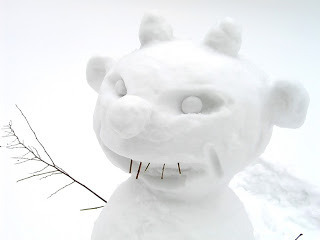 Last week's Christmas Superstitions included The Good, the Bad and the Scary. This week's installment brings you some traditions that are downright creepy! They may not be true, but there's bound to be at least a couple that will give you a chill just the same.
Last week's Christmas Superstitions included The Good, the Bad and the Scary. This week's installment brings you some traditions that are downright creepy! They may not be true, but there's bound to be at least a couple that will give you a chill just the same.Dogs that howl on Christmas Eve will go mad before the end of the year. A candle or a lamp should be kept burning all night on Christmas Eve to avoid a death in the house in the following year.
Instead of water turning into wine at midnight on Christmas Eve, some hold the belief that the water in streams and wells turns into blood! Not only that, if you witness this change, you'll die within the year!
 A Scandinavian belief maintains that it's dangerous to go out on Christmas Eve because of the many supernatural beings that come out of their hiding places that night. Trolls, witches, goblins and ghosts are said to roam freely, including the spirits of the dead revisiting their previous homes. Gifts must be left outside – bowls of pudding and cream, clothes, tobacco and even ale – in order to appease some of these creatures. The most perilous time occurs between cock's crow and dawn, when supernatural beings are at the peak of their power. To go outside means risking death or being carried off by them, never to be seen again.
A Scandinavian belief maintains that it's dangerous to go out on Christmas Eve because of the many supernatural beings that come out of their hiding places that night. Trolls, witches, goblins and ghosts are said to roam freely, including the spirits of the dead revisiting their previous homes. Gifts must be left outside – bowls of pudding and cream, clothes, tobacco and even ale – in order to appease some of these creatures. The most perilous time occurs between cock's crow and dawn, when supernatural beings are at the peak of their power. To go outside means risking death or being carried off by them, never to be seen again.Swedish folklore puts a chilling twist on this story. On Christmas Eve, they prepare their dining room with food and ale and blazing fire – and leave it overnight to enable the spirits of the dead to celebrate undisturbed. The family checks the chairs in the morning for traces of earth, proof that the dead have come calling!
 Icelandic children lived in fear of being eaten by bloodthirsty ogres living in the mountains. The most ferocious of these was Mother Grýla, who wandered through the village at Christmastime with her evil cat.
Icelandic children lived in fear of being eaten by bloodthirsty ogres living in the mountains. The most ferocious of these was Mother Grýla, who wandered through the village at Christmastime with her evil cat. Instead of leaving out cookies for Santa, gifts and food had to be left out to appease the ogres. If they didn't like the offerings, they'd eat you. And if you didn't have at least one brand new article of clothing in honor of the season – the cat would eat you!
A once popular parlor game gave everyone an apple after dinner, which was then cut in half across the middle to reveal the pattern of the core. If the core is star-shaped (most apples have this), the owner of the apple will see another Christmas. If the core is a different shape, the owner's death will occur in the next twelve months! The appearance of a four-pointed cross was worst of all – although what was worse than death is never mentioned.
Parlor games in Victorian England also included telling ghost stories by the fire, while keeping tabs on everyone's shadow throughout the evening. If anyone's shadow were to appear headless, that person would die within the coming year.
 While most cultures consider it lucky to be born on Christmas, others definitely do not. In Greece, any child born during the 12 days of Christmas is in danger of morphing into a kallikantzaroi, a malevolent half-animal, half-human monster that lives underground most of the year. Such a creature will almost certainly devour his own brothers and sisters!
While most cultures consider it lucky to be born on Christmas, others definitely do not. In Greece, any child born during the 12 days of Christmas is in danger of morphing into a kallikantzaroi, a malevolent half-animal, half-human monster that lives underground most of the year. Such a creature will almost certainly devour his own brothers and sisters!In Romania, Poland and Moldova, a child born on Christmas Day may become a werewolf. A different variation on this tale is that any child conceived during Advent (when parents apparently were supposed to abstain from such activities) was almost certainly doomed to become a were-animal by the time they reached adulthood. In some Slavic regions, a child be born anywhere between Christmas and Ephiphany will surely become a vampire after death.
To avoid bad luck, all Christmas decorations should be taken down by Candlemas (Feb. 2). However, make sure you clean up after them – every needle left behind in the house from the Christmas tree will cause the sighting of a spirit or a demon in the coming year. Some believe a stray needle or berry will result in a death in the family. (A good case for having an artificial tree!)
The danger isn't over once the decorations are down because a Christmas tree thrown outside will attract the attention of evil spirits and supernatural beings. For proper disposal, the tree must be burned immediately.
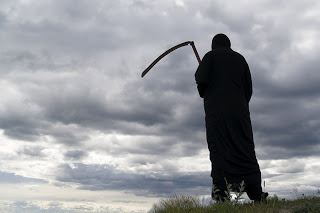 An old Breton tale tells the story of a blacksmith who refused to stop working after the church bell had rung for Midnight Mass on Christmas Eve. Suddenly a tall man entered his shop with a scythe that needed mending.
An old Breton tale tells the story of a blacksmith who refused to stop working after the church bell had rung for Midnight Mass on Christmas Eve. Suddenly a tall man entered his shop with a scythe that needed mending. The blacksmith did the work but the mysterious man refused to pay him. Instead, he told the blacksmith to send for a priest because this work would be the last he would ever do. By the time the roosters crowed on Christmas morning, the blacksmith was dead. He had mended the Scythe of the Grim Reaper himself.
Wishing you a merry-not-too-scary holiday season!
Dani Harper
http://www.daniharper.com/
Your turn -- have you heard of any other superstitions concerning Christmas?
Published on December 22, 2010 21:37
December 19, 2010
The Longest Night - Winter Solstice
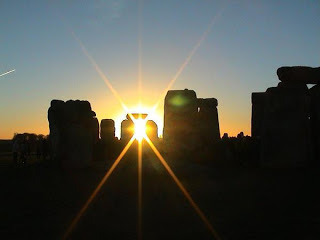 The Winter Solstice is probably the most celebrated annual event worldwide, both now and in the past. Our ancestors rejoiced in the return of the sun, seeing it as a rebirth of life as well as light. Many ancient cultures created incredible structures to align with the sun during solstices. One of the most famous examples of this is Stonehenge, but it's just one of hundreds of megalithic sites across Europe designed to mark these important days in the astronomical calendar. Ancient inhabitants of the New World, such as the Incas, built similar structures.
The Winter Solstice is probably the most celebrated annual event worldwide, both now and in the past. Our ancestors rejoiced in the return of the sun, seeing it as a rebirth of life as well as light. Many ancient cultures created incredible structures to align with the sun during solstices. One of the most famous examples of this is Stonehenge, but it's just one of hundreds of megalithic sites across Europe designed to mark these important days in the astronomical calendar. Ancient inhabitants of the New World, such as the Incas, built similar structures. Winter Solstice, usually called Yule, falls on December 21 in 2010, and it marks the shortest day and longest night of the year. For those of us who struggle with the annual darkness, it draws the line between one half of the year and the other. After this day, the days will lengthen once more and light will increase.
The holiday now known as Christmas has its origins in many long ago Yule celebrations.
The Yule Log
 Medieval tradition tells of an enormous log – commonly ash or oak – placed in the fireplace on the solstice. It was decorated with evergreens and kindled with the carefully saved remains of last year's Yule log. The wood would burn all night, then be allowed to smolder for the following 12 days. Pouring ale or wine on the log was customary. So was sprinkling flour or breadcrumbs on it, or even placing coins on the log. All were said to bring good fortune, and the blackened coins were later given as gifts.
Medieval tradition tells of an enormous log – commonly ash or oak – placed in the fireplace on the solstice. It was decorated with evergreens and kindled with the carefully saved remains of last year's Yule log. The wood would burn all night, then be allowed to smolder for the following 12 days. Pouring ale or wine on the log was customary. So was sprinkling flour or breadcrumbs on it, or even placing coins on the log. All were said to bring good fortune, and the blackened coins were later given as gifts.Remnants of the Yule log were said to have protective properties and were kept in the house to guard against lightning and hail, and against various diseases. Ashes of the log were mixed with cattle and poultry fodder to ensure that the livestock thrived in the coming year.
Later, as large fireplaces fell out of fashion, small logs were decorated in a similar way and holes were bored into the wood to hold candles, which would be burned for 12 nights. The French were the first to create an edible Yule log, and Victorian confectioners made these Yule cakes famous.
The Yule Tree
Celtic customs are said to have called for the decorating of sacred oak trees. The Celts and many other peoples also held evergreens to be symbolic of immortality, of continuing life in the midst of death. In the coldest, darkest and dreariest of winters, evergreens held forth hope of returning spring. Throughout many cultures and over countless centuries, homes have been decorated with evergreen boughs and other winter greenery.
The practice of decorating trees dates back to before Roman times. The trees were not cut down and brought into the house, however, but left alive and decorated wherever they grew with trinkets, trophies, sacred plants such as holly and mistletoes, bits of metal and sometimes replicas of gods.
The Yuletide Wreath
Wreaths have symbolized the wheel of the year since ancient times, and the word wreath comes from the Old English writhen, meaning "to twist". In many European countries, evergreen wreaths were lit with candles during the darkest winter days, symbolizing hope that light would return. Candles were sometimes placed around a wheel, to ensure that the year would cycle around so that the days would lengthen and warmth return. Holly wreaths were said to ward off the evil spirits that abounded during the darkness of midwinter, and holly might be kept near the door all year long to invite good fortune.
The Yule Goat
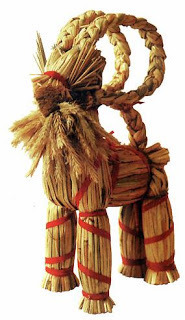 The Yule Goat or Julbock was central to solstice traditions in Scandinavia and northern Europe. A human dressed in goatskins and wearing long horns acted out a skit in which he "died" and returned to life. This was symbolic of the sun's resurrection at solstice. (The goat guise was chosen because the Norse thunder god Thor had two goats which drew his chariot across the sky. He would occasionally kill the goats and use them to feed guests, then would restore them to life with a blow of his magical hammer.)
The Yule Goat or Julbock was central to solstice traditions in Scandinavia and northern Europe. A human dressed in goatskins and wearing long horns acted out a skit in which he "died" and returned to life. This was symbolic of the sun's resurrection at solstice. (The goat guise was chosen because the Norse thunder god Thor had two goats which drew his chariot across the sky. He would occasionally kill the goats and use them to feed guests, then would restore them to life with a blow of his magical hammer.) Goats were originally slaughtered as offerings during Yule, but later, goats made of straw were created annually as both decorations and effigies. This webcam site shows the current giant straw goat in Gävle, Sweden http://www.camcentral.com/camviewer.php?id=16960&script=listings&task=map&item=location&show=Sweden
Other Winter Solstice traditions
Many people celebrate by staying awake throughout the night of the solstice so they can watch the sunrise the following day. Others wake early to observe the daybreak and dawn of a new cycle. Bonfires are usually lit to simulate the ascent of the sun and sometimes herbs such as sage are thrown into the blaze. Candles are allowed to burn throughout the day. Gifts are often exchanged as part of the midwinter celebrations, and stories told of ghosts and fairies.
Songs are sung, especially carols such as Deck the Halls which mention Yule specifically. Toasts are made and, in some places, groups go "wassailing", which is very much like caroling. "Wassail" comes from an Anglo-Saxon toast for "Be Well" or "Be Healthy". In modern times, the revelers go door to door, carrying "Wassail cups" that will hopefully be filled at each house.
In ancient times, wassailing was done around the oldest tree in an apple orchard. Cider was poured on the roots and toast dipped in cider was hung on the branches to thank the tree dryads and ensure a good crop in the coming year. The carolers sang and drummed to drive away bad spirits, and the wassail cup was passed from person to person. Each took a drink and passed on the cup with a kiss and a blessing.
One of the most unique solstice traditions is the lighting of the White Horse on the hillside at Alton Barnes in England. The mammoth chalk figure is outlined by candles placed in glass jars on the day of the winter solstice. When night falls, only the flaming outline of the horse is visible. Here's a video on YouTube of last year's lighting.
The Reason for the Season
The word solstice comes from Latin for "stoppage". The sun is at its lowest point in the sky and its elevation at noon appears to be the same for several days before and after solstice. Winter solstice is often called Yule, probably from an old Nordic word for wheel. With the coming of Yule, the wheel of the year has rolled around to its beginning once more. The Celts believed that that wheel paused briefly on this day as the sun itself appears to stop. Accordingly, they wouldn't turn a wheel or even a butter churn on this day. A time of stillness was prized as an opportunity to reflect on the past year and look forward to the new one.
This reflection is still at the very heart of all midwinter celebrations. It's a time to meditate on the sorrows of the past year as well as the positive moments and achievements. It offers a chance to bond with family and friends, and to look forward with hope.
Dani Harper
http://www.daniharper.com/
Your turn – Do you celebrate the winter solstice or Yule? What are some of the other traditions you know of?
Published on December 19, 2010 22:34
December 14, 2010
Beware Krampus, the Christmas Demon!
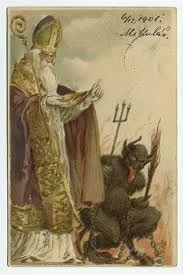 Our North American Santa Claus is loosely based on the European Saint Nicholas, a kind, gift-giving fellow traditionally portrayed in long bishop's robes instead of a red suit. Saint Nick grew out of stories about an actual person, Nikolaos of Myra, a Greek bishop with a reputation for secret gift-giving such as leaving coins in shoes and working miracles.
Our North American Santa Claus is loosely based on the European Saint Nicholas, a kind, gift-giving fellow traditionally portrayed in long bishop's robes instead of a red suit. Saint Nick grew out of stories about an actual person, Nikolaos of Myra, a Greek bishop with a reputation for secret gift-giving such as leaving coins in shoes and working miracles.So understanding Saint Nicholas is easy. It's the company he keeps that raises questions and eyebrows. In Austria, Hungary, Bavaria and other Alpine countries, St. Nick's assistant isn't a cute little elf, it's an enslaved demon. Yup, that's right. D-E-M-O-N. This cloven-hoofed creature goes by many names, but most commonly is called Krampus, which is Old High German for claw.
 KrampusPerhaps the word for "long" would have suited him better. Not only does Krampus have lengthy talons, but sports exceptional horns on his head as well. His seven-foot tall body is usually covered with long shaggy hair (often black), he has a long tail and he has a tongue longer and more prehensile than that belonging to Gene Simmons' demon character of KISS fame.
KrampusPerhaps the word for "long" would have suited him better. Not only does Krampus have lengthy talons, but sports exceptional horns on his head as well. His seven-foot tall body is usually covered with long shaggy hair (often black), he has a long tail and he has a tongue longer and more prehensile than that belonging to Gene Simmons' demon character of KISS fame. If all that weren't intimidating enough, Krampus is not only a demon, but an incubus. That's a demon who sexually preys on sleeping humans! (Santa hangs out with a predator?!)
 St. Nick and his goons
St. Nick and his goonsSo while St. Nicholas got all the positive press by delivering gifts and treats to "good" boys and girls, Krampus was right by his side to dish out not just warnings but punishment to the "bad" children, and sometimes to adults too. In some places, the jolly old saint was accompanied by not one but several demons – his own personal gang of enforcers!
If you weren't saying your prayers, doing your chores and being properly respectful to elders, the penalty wasn't a mere lump of coal in your stocking. Krampus was armed with chains, a bag or basket and bundles of switches. If you were lucky, Krampus only took all your presents for himself. More often, you'd be spanked or even beaten. In some towns, kids had to run a long gauntlet of people dressed as Krampus and armed with switches!
 Krampus taking "bad" children to HellReally naughty kids were allegedly shackled with chains or stuffed in a bag or basket, and carried off to Hell to burn forever – at least, that's what children were told. In Switzerland, where Krampus is called Schmutzli, children were routinely threatened with being carried off to the dark forest by the demon or tied in his sack to be thrown in the river and drowned!
Krampus taking "bad" children to HellReally naughty kids were allegedly shackled with chains or stuffed in a bag or basket, and carried off to Hell to burn forever – at least, that's what children were told. In Switzerland, where Krampus is called Schmutzli, children were routinely threatened with being carried off to the dark forest by the demon or tied in his sack to be thrown in the river and drowned! We've all seen little kids who are intimidated or downright terrified of department store Santas (some of us WERE those little kids!). How on earth did European children cope with seven-foot demons threatening them? Were they tougher than today's kids or were they scarred for life? Psychological studies hadn't been invented when St. Nick's sinister sidekick first popped up in Germanic folklore around 1600. And the whole Christmas demon concept probably goes all the way back to pre-Christian winter solstice celebrations when pagan deities were said to roam the night.
 Greetings from Krampus!Krampus' popularity grew until eventually he got his own day. Krampusnacht was usually December 5th which is the eve of St. Nicholas Day in many regions. In some places, there were entire Krampus festivals held, where young men dressed up like demons and terrorized the local children (and unwary young women) for days. By the way, the reward for this important public service was beer and other spirits. Many of these traditional festivals continue to this day.
Greetings from Krampus!Krampus' popularity grew until eventually he got his own day. Krampusnacht was usually December 5th which is the eve of St. Nicholas Day in many regions. In some places, there were entire Krampus festivals held, where young men dressed up like demons and terrorized the local children (and unwary young women) for days. By the way, the reward for this important public service was beer and other spirits. Many of these traditional festivals continue to this day.In the 1800s, while the Victorians were developing the notion of sending pretty Christmas cards, a trend emerged in some European countries to send scary, lewd and suggestive postcards of the yuletide demon! Instead of Happy Holidays or Merry Christmas, these cards usually said "Greetings from Krampus!" (About as cheery to receive as "Compliments from Satan"!)
 So the next time you start wishing for a real old-fashioned holiday, try singing "Krampus the Christmas Demon" to the tune of "Rudolph the Red-nosed Reindeer" and remember that the season of goodwill once had a very dark and disturbing side!
So the next time you start wishing for a real old-fashioned holiday, try singing "Krampus the Christmas Demon" to the tune of "Rudolph the Red-nosed Reindeer" and remember that the season of goodwill once had a very dark and disturbing side!Dani Harper
http://www.daniharper.com/
Your turn! Have you ever heard tales of the Krampus? Got any other scary Christmas traditions to share? By the way, have a look at this book on Amazon - The Devil in Design: The Krampus Postcards

Published on December 14, 2010 20:41
December 12, 2010
Christmas Superstitions - Part One
 Tis the season to dust off favorite blogs of Christmases past. For anyone who might have caught this one already, hope you enjoy it a second time!
Tis the season to dust off favorite blogs of Christmases past. For anyone who might have caught this one already, hope you enjoy it a second time!As you know, I just can't resist anything related to the paranormal. But Christmas? Who would have suspected that there was anything supernatural about such a warm fuzzy holiday? I mean, a big jolly fellow travels all over the world with his flying reindeer in a single night, squeezes down tiny chimneys with a neverending bag of presents, knows if you're naughty or nice but is never seen himself… Come to think of it, that IS pretty paranormal!
I had a lot of fun researching Christmas superstitions and I was amazed by how MANY there were! In fact, there's so much material I've decided to blog twice about this topic. Here then is the first installment. (By the way, here's the official disclaimer -- Remember, these are folktales and traditions, and not intended to be taken as truth!)
The Good….
Unmarried girls can cut a twig from a cherry tree on St. Barbora's Day (Dec. 4th) and put it in water. If it blooms by Christmas Eve, marriage will follow within the year. Counting the stars on Christmas Eve will foretell the number of sheaves in your harvest. And if you see the sun shining through the limbs of the apple trees on Christmas Day, there'll be an abundance of fruit the following year.
If you dream on any of the 12 nights between Christmas and Epiphany (Jan. 6), your dreams will come true in the next year. The first person in the household to hear a rooster crow or anyone who hears a cricket chirp on Christmas Day is going to have a very lucky year. Good luck follows those who give money to the poor on Christmas Day, to those who eat their breakfast by candlelight, and to those who stir the Christmas pudding.
The Bad….
Bad, bad fortune follows those who leave the dishes unwashed on Christmas Eve (and that's on top of what Mom will do to you!). On Christmas Day, it's unlucky to leave the dinner table before everyone has finished. A full moon on Christmas predicts a scanty harvest in the year to come. If Christmas Day falls on a Thursday, a year of windy weather is forecast.
On Christmas Eve it's said that you can hear the bells of lost churches that have been covered by floods or buried by landslides and earthquakes. Picking up nuts or fruit from the ground will bring bad luck. So will sending carolers away without treats or money. And you really don't want to be the first one home from church!
And the Scary….
A piece of winter greenery (holly, mistletoe, evergreen, etc.) must be brought into your home during the Christmas season, to keep away evil spirits. However, every winter leaf left in the house after Candlemas (Feb. 2) will result in the sighting of a ghost, or perhaps even a death in the house during the coming year! Mistletoe must be burned, or those who kissed beneath it will become enemies.
Those born on Christmas Day are rumored to be able to see ghosts and spirits. And those who are born on Christmas Eve are said to turn into ghosts themselves on that day every year! (Wow, this sounds more like Halloween, doesn't it?) The only way to avoid this odd fate is to remain awake the entire night until Christmas Day dawns.
That's all for this post. Watch for more on Christmas superstitions!
Dani Harper
http://www.daniharper.com/ Changeling Moon

YOUR TURN! What Christmas superstitions or folklore have you heard of over the years?
Published on December 12, 2010 16:52
December 6, 2010
The Myth and Lore of Mistletoe
 -- Mistletoe is the official state flower of Oklahoma! --Today we use mistletoe as a Christmas decoration (and occasionally steal a kiss under it). But mistletoe has a much longer history than Christmas itself.
-- Mistletoe is the official state flower of Oklahoma! --Today we use mistletoe as a Christmas decoration (and occasionally steal a kiss under it). But mistletoe has a much longer history than Christmas itself. Mistletoe is unusual in the plant world because it doesn't grow in the earth at all. Instead, it's an aerial parasite that lives only in the boughs of trees. This uncommon plant not only remains green throughout the winter, but produces its pure white berries right around the time of the winter solstice.
The ancient Celts believed mistletoe to be a sacred gift from the gods. The Romans recorded that the Celts would harvest mistletoe from a tree after the winter solstice. A druid – a Celtic priest – used a golden sickle to cut the plant. It was vital that the mistletoe never come in contact with the ground and so a white cloth was held beneath the tree to catch it. Two white bulls were then sacrificed to honor the god who provided the mistletoe and to petition him to increase the plant's potency.
The druids were said to be skilled in both herbs and magic, and the mistletoe was one of the most powerful plants in their arsenal. A symbol of immortality, mistletoe was believed to have protective powers against evil spirits and the ability to heal diseases. Although mistletoe is a poisonous plant itself, in skilled hands it was considered to be an antidote to all poisons. It was also used to promote fertility of both animal and human and occasionally even used in aphrodisiac potions. This sacred plant was associated with good fortune and great blessings.
 The mistletoe was so sacred that if enemies met in a forest and a mistletoe plant was spotted overhead, an automatic truce was declared until the following day. From this grew the practice of hanging mistletoe over the door, or suspending it from the ceiling as a symbol of peace and good will.
The mistletoe was so sacred that if enemies met in a forest and a mistletoe plant was spotted overhead, an automatic truce was declared until the following day. From this grew the practice of hanging mistletoe over the door, or suspending it from the ceiling as a symbol of peace and good will. The Norse myth of Baldur takes us to the next phase of mistletoe tradition. The goddess, Frigga, was Baldur's mother, and exacted a promise from every element, plant and animal, both on the earth and under the earth, not to harm Baldur. She forgot the mistletoe, which grows neither in the ground or on it. Loki, prankster and god of evil, tricked another god into shooting Baldur with an arrow made of mistletoe, which killed him. Fortunately, Balder is eventually brought back to life. His mother is so overcome with joy that she reverses the reputation of the offensive mistletoe, declaring that those who passed beneath a mistletoe plant should have a token kiss and be kept safe from harm.
Centuries later, both Celtic and Viking traditions were condemned by early Christianity as pagan, and mistletoe was forbidden to be displayed within sight of the church. However, that didn't stop people from hanging mistletoe in their homes and barns or from wearing sprigs of it to ward off disease and evil. Mistletoe became known as All-heal, and is still used in homeopathic medicine.
It wasn't until Victorian times that the plant's original status as a symbol of peace and love was revived, and the practice of kissing under the mistletoe was reinstated.
Dani Harper
www.daniharper.com
Your turn --- In your wildest fantasy, who would YOU like to meet under the mistletoe?
Published on December 06, 2010 16:12
December 2, 2010
CHANGELING MOON - upcoming shapeshifter novel
Just got the cover art for the first book in my upcoming shapeshifter series with Kensington. This story is classed as paranormal romance, but you'll find plenty of action and suspense in it. I'm really excited and looking forward to the release in May. It's soooo hard to wait, so I thought I'd share a preview with everyone!
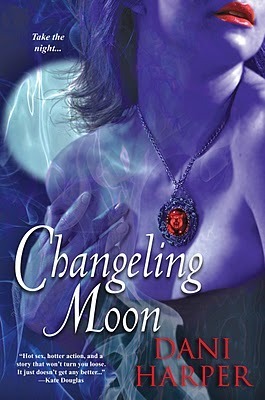 BOOK ONE
BOOK ONE
Changeling Moon
by Dani Harper
He roams the moonlit wilderness, his every sense and instinct on high alert. Changeling wolf Connor Macleod and his Pack have never feared anything — until the night human Zoey Tyler barely escapes a rogue werewolf's vicious attack.
As the full moon approaches, Zoey has no idea of the changes that are coming, and only Connor can show her what she is, and help her master the wildness inside. With her initiation into the Pack just days away and a terrifying predator on the loose, the tentative bonds of trust and tenderness are their only weapons against a force red in tooth, claw … and ultimate evil.
ADVANCE REVIEW
"Dani Harper's CHANGELING MOON is one of those rare stories that literally catches you with the first paragraph and never lets go.
"Powerful characters, fantastic action and a really unique premise set this story apart from every other shapeshifter story I've read. Her Changeling world is unique and well-drawn and the pacing will keep readers turning those pages to see what's coming next.
"A strong heroine with a mind of her own, a compassionate yet powerful hero, hot sex, hotter action, and a story that won't turn you loose. It just doesn't get any better than CHANGELING MOON. I highly recommend this one.
"Make room on the keeper shelf — Dani Harper is definitely an author to watch."
~ Kate Douglas ~ Author of the DemonSlayer and Wolf Tales series
ABOUT THE SERIES
There are three books in the series at present. Changeling Moon will be released on May 31, 2011, followed by Changeling Dream on June 28. Changeling Dawn is slated for release in January of 2012. All are coming out in Kensington's Brava line.
PS - Changeling Moon can already be pre-ordered on Amazon!
Dani Harper
www.daniharper.com
Your turn - What do you think of the artwork? Would it inspire you to take a look at the book? What about the premise of the story? Are you a fan of paranormal romance?
 BOOK ONE
BOOK ONEChangeling Moon
by Dani Harper
He roams the moonlit wilderness, his every sense and instinct on high alert. Changeling wolf Connor Macleod and his Pack have never feared anything — until the night human Zoey Tyler barely escapes a rogue werewolf's vicious attack.
As the full moon approaches, Zoey has no idea of the changes that are coming, and only Connor can show her what she is, and help her master the wildness inside. With her initiation into the Pack just days away and a terrifying predator on the loose, the tentative bonds of trust and tenderness are their only weapons against a force red in tooth, claw … and ultimate evil.
ADVANCE REVIEW
"Dani Harper's CHANGELING MOON is one of those rare stories that literally catches you with the first paragraph and never lets go.
"Powerful characters, fantastic action and a really unique premise set this story apart from every other shapeshifter story I've read. Her Changeling world is unique and well-drawn and the pacing will keep readers turning those pages to see what's coming next.
"A strong heroine with a mind of her own, a compassionate yet powerful hero, hot sex, hotter action, and a story that won't turn you loose. It just doesn't get any better than CHANGELING MOON. I highly recommend this one.
"Make room on the keeper shelf — Dani Harper is definitely an author to watch."
~ Kate Douglas ~ Author of the DemonSlayer and Wolf Tales series
ABOUT THE SERIES
There are three books in the series at present. Changeling Moon will be released on May 31, 2011, followed by Changeling Dream on June 28. Changeling Dawn is slated for release in January of 2012. All are coming out in Kensington's Brava line.
PS - Changeling Moon can already be pre-ordered on Amazon!
Dani Harper
www.daniharper.com
Your turn - What do you think of the artwork? Would it inspire you to take a look at the book? What about the premise of the story? Are you a fan of paranormal romance?
Published on December 02, 2010 00:54



